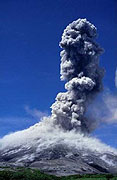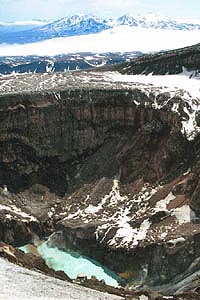|
|
DESTINATIONS: |
 |
Kamchatka: where the Earth bares its soul
FAQ - Frequently Asked Questions1. Why should I visit Kamchatka? It is a special peninsula, because it does not have any road communications with the continent. Also it became partly open for foreigners and most of in-land Russians only in 1990, because of its strategic location. Therefore now it still preserves unique nature of the Earth and looks like the rest of the world did few million years ago. Kamchatka is a mountain country with 29 active and more than 160 extinct volcanoes, with hundreds of hot springs, crystal-clear wild streams and rivers. Several national NPs can easily compete and conquer with Yellowstone and Iceland, because of the main advantage - real wilderness of their beauty. Several distinct types of vegetation such as coastal forest, taiga and tundra can be found on the peninsula. This rich diversity provides habitat for a large number of mammals, fish and birds. It has the largest population of brown bear and a home of rare Steller's Eagle. During summer season a tremendous show of salmon comes up in Kamckatka's rivers. Some peculiar features account of complete absence of snakes, frogs and poison ticks, which are very common in Siberia. Kamchatka is one of the most active segments of the “Fire Ring”, a chain of volcanoes that rim the Pacific Ocean. Some volcanoes are very hazardous like 4750 m (15580 ft) Klyuchevskaya Sopka, the highest peak in the region and the highest active volcano in Eurasia. Local indigenous tribes Itelmens, Koryaks and Evens still keep nomadic life. As rain deer herders they can be found in the central part of the peninsula wearing traditional animal skins and carrying collapsible ger-a-like houses. Today Kamchatka is a great destination for adventure sport activities. During the short 2 months summer it's a place for unforgettable hiking, trekking or climbing. In spring it's the place for heli skiing, snow boarding, telemax, ski-touring. Annually the world-known dog sled race "Berengia" takes place here in April. Also it's a unique place for birds watching, wilderness travel and of course sport fishing. 2. What is worth to visit on Kamchatka? The first and the most famous thing to see is the Valley of Geysers, where one can go only by helicopter. The other things are the hot springs of Paratunka, the trail to the Nalychevo valley, volcanoes around Petropavlovsk, Esso village with its indigenous Koryak people, bird bazaars on the Comandor's Islands. 3. What about renting a car and driving? Believe it or not, but there are no car rent companies on Kamchatka. Locals drive on the right-hand side of the road, although most of the cars are imported from Japan and have right side sterling. Driving conditions are very different from those in the United States and Western Europe: most roads outside Petropavlovsk-Kamchatsky are just dirt, signs are small and local drivers have a well-earned reputation as reckless. Basically there is only one "highway", which goes from P.-K. to the north and ends up in Esso village. Public buses run daily between them. The other roads need as a rule an off-road vehicle, but even that does not always work out. Taxies in the city work quite well and available at most of the road nuts. 4. Can I use credit cards, traveler’s checks and foreign exchange? The travelers’ checks and credit cards have not yet fully penetrated to Kamchatka. Only one bank in Kamchatka accepts traveler’s checks. You can use VISA and MASTER CARDS in few shops and restaurants in Petropavlovsk-Kamchatsky city. So practical advise is to use local cash, which is Russian rubles for all local expenses. Rubles may be purchased at the airport, banks, some hotels and at numerous exchange offices in Petropavlovsk-Kamchatsky. Also it would be no problems to exchange Japanese yens and Chinese yuans. If you plan to travel to P.-K. via Moscow then take the best exchange rate in Moscow. 5. What is food like in Kamchatka? In general food in Kamchatka is the same as in the most territory of the European part of Russia. In P.-K. restaurants you can order sea food including famous Kamchatka's crabs and fresh salmon, Korean, Chinese and Japanese cuisine. Most of the fresh food on the local market is imported from in-land Russia, the USA, China, New Zealand and Central and South America. That is why it's quite expensive. Tomatoes, cucumbers, potatoes, carrot, cabbage and some other vegetables are grown locally. People believe that strawberry, which they grow in soils rich of minerals from volcanoes, is one of the best in the world. Such a not typical berry for severe climate and all the other veges are growing without any chemicals here. Read more about food in the Food section. 6. What are electrical appliances in Kamchatka? If you take any electrical equipment that is not battery-operated, you will need a two round-pin plug adapter, a 220-volt/50 hertz converter and state-of-the-art surge protector, especially for delicate computer equipment. Electrical current surges of 20 to 30 volts are not uncommon. 7. Is it difficult to get to the Internet in Kamchatka? At the end of 2001 it was only one internet cafe "Planet Samsung" in the city of P.-K. 8. Could I travel on Kamchatka independently? In theory it's possible as there is no restriction to this. However, the travel industry is not well-developed in this region and it's truly wild. If you know Russian language and familiar with general Russian traditions it's O.K. just to land in Elizovo airport and find your way using communication skills. If you do not know the language it would be rather difficult to get to a hotel as there are no signs or marks in English. Also most of the areas on Kamchatka are restricted till today and one need a special permit to go to many destinations around P.-K. This permit can be arranged by licensed tour operators or public organizations like a local hiker's club or eco-tourism federation. Otherwise one has to deal with FSB office or the office of the national park reserves that would take ages. More convenient is to deal with ground outfitters, which are able to arrange a tailor-made tour for a reasonable price. Also it's much saifer to hire a local guide, who would be a real support in awkward situations at the check posts or in many public places. “Wild Russia” company can organize most of the tailor-made trips to Kamchatka according to client's plan. 9. What to expect on a typical trip to Kamchatka? Usually our guides meet people off the plane at the Elizovo airport. Sometimes when a group is traveling via Moscow or Khabarovsk they meet the group in these gate cities. We prefer to not stay in the city as it does not look very impressive, but in Paratunka village as it really reflects what Kamchatka is. On the first evening we talk about the coming trip with all the details and check the gear. Next day we departure according to a program. Kamchatka has a rough terrain, so expect to get a 3-4 hours drive on a dirt road on most of our trips. On a trek we carry our loads with little support from the local guides. Practically staff like porters in Nepal does not exist on Kamchatka. Our trekking crew consists of an experienced English speaking trek leader, a couple of local guides, a cook and a kitchen boy. On a trek we sleep in tents, cook on the open fire where possible. For more luxurious journeys we travel by jeeps or off-road tourist vehicles, which are combination of an off-road truck and a soft seats bus with big windows. Staying in reasonable comfortable chalets and lodges we can approach volcanoes and have opportunities for a day hike up to their foot hills and more. Meals during a day include breakfast (tea, Nescaffe, porridge, salami, canned cheese, cookies, jam, boiled eggs, salmon caviar), lunch and dinner. Lunch consists of a soup, tea and noodles or boiled potatoes. Dinner usually includes a fresh veg salad, soup, main course - usually just taken cooked well salmon and dessert. During a day we hiking, jeeping or rafting for 3-4 hours before lunch and 3 hours after lunch. On a trip the leader tells lot of stories about Kamchatka's wildlife, local tribes traditions, trekking routes and explorer's jokes. 10. How safe it is to travel on Kamchatka? You should understand that Kamchatka is a wild corner of the world. Medical services in P.-K. are quite basic, in the villages only first aid and emergency are available. Also telecommunications do not work regularly out of P.-K. And to get back from a trip to the nearest medical post would be 4-6 hours. So plan your trip carefully, inform "Wild Russia" (see the trip application form) staff about your medical history, maybe talk to your doctor and insurance agent. There is no need for special medical shots practice or requirement before going to Kamchatka. However while traveling in the wilderness one should follow common sense - stay away of wild creatures, no risky jumps in the rivers, no lonely walks in the bush. Get more instructions about it from your trip leader. 11. Should I have some serious experience to go to Kamchatka? In most of the cases it's not the must, but some general adventure travel experience would be an advantage. So it's good to advise "Wild Russia" about your experience in advance (see the trip application form). |
|
Wild
Russia / Neizvedanny Mir Company
Saint Petersburg, Fontanka embankment, 59
+7 812 703-3215
+7 812 703-3216
+7 812 703-3249
Email: info@wildrussia.spb.ru
